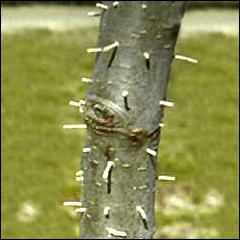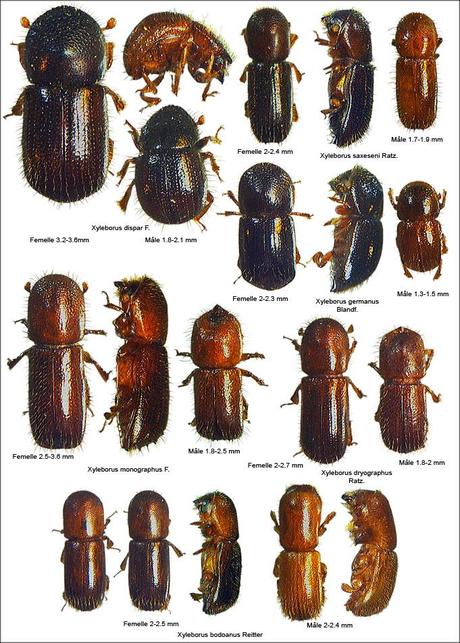This came to light again just the other day. I received an e-mail from the one of the many horticulture and gardening websites that I subscribe to and it was about a fungus and a beetle causing havoc with the Avocado crops in California. I know what you are asking, If you live in South Carolina, WHY are you worried about an Avocado problem in California? There are a couple of reasons:
1) I am a geek and I like to know what could possibly end up here due to somebody inevitably bringing it here by mistake or stupidity. I am attempting to grow Avocados.
2) I buy Avocados in the store on occasion, and I want to know why the price could/is going up.
Anyway, while I was reading this article there was a picture that sent off all kinds of "familiar" images in my head, I KNOW I have seen this before. That picture was this:

What you are looking at is strings of compacted sawdust being pushed out of the trunk of the tree. I was right I had seen it before. This damage was being caused by an Ambrosia Beetle and I had them in a Royal poinciana (Delonix regia) tree that I was growing. The tree died and had these strings of sawdust coming out. I disposed of the tree, which in hindsight was a good idea, because at the time I had NO IDEA what the heck it was. I do now.
There about 3,000 known beetle species employing the ambrosia strategy. Ambrosia beetle is a generic term used to refer to a number of beetles. This "strategy" is a relationship between the beetles and the Ambrosia fungus.
This is how it works. The beetles dig holes, usually in dieing or stressed trees but some species use live, healthy ones. These tunnels are called galleries. The beetle carries spores of the Ambrosia fungus with it and then deposits them in these galleries. The fungus penetrates the plant's tissue, digests it, and grows near the surface of the beetle's gallery. The beetles then feed upon the fungus. The tree ends up dieing, in the case of a live tree infestation, because the fungus in essence "clogs" up the trees arteries.
The beetle that is causing the problem in California is known as the Tea Shot Hole Borer. It is an exotic ambrosia beetle smaller than a sesame seed. The information is still coming in as to how expansive the damage is.
Down in Florida they too are having a problem with Avocados, but because of a different beetle. There, it is the Redbay Ambrosia Beetle. This one was first detected in Port Wentworth, Georgia in 2002. Back in that year, this beetle, Xyleborus glabratus, was the twelfth species of non-native ambrosia beetle known to have become established in the US. All are suspected to have been introduced in solid wood packing materials, such as crates and pallets.
One other beetle I am trying to keep an eye on is the Granulate Ambrosia Beetle (Xylosandrus crassiusculus). This one was introduced to South Carolina from Asia in the early 1970’s. It has since spread throughout the southeast, gulf coast and as far north as Maryland. This tiny beetle is a pest of woody ornamental, fruit, and nut trees and can cause significant damage in nursery, landscape, and orchard settings.
Here in the southeast, Georgia and South Carolina, the ambrosia beetle’s first flight occurs with mild weather typically in February but possibly as early as January. Young trees in nurseries and trees that have been in landscapes for less than three years old are vulnerable to attack even if they are not obviously stressed.
Ambrosia Beetles come in many shapes, sizes and colors, as seen by this picture:

They are all usually very small. How to tell if you have an infestation? I mentioned the strings of sawdust protruding from the tree. This may not always be visible however because rain and wind can knock this very fragile powder off. Other signs to look for are, piles of fine, whitish dust found around entrance holes or at the base of the tree. Wilting of the new leaves, which can also be associated with other problems, is a secondary confirmation sign. You should also monitor the bark very closely for holes as small as 1/16 of an inch.
Keeping your trees healthy is one of the most important defenses against attack. Preventative applications of pyrethroid insecticides can protect trees, if sprayed when the beetles are active at the first signs of warmer weather, late Winter, early Spring. Read the label of anything that you use. When looking for an insecticide to work on Ambrosia Beetles, look for some type of borer listed on the label. Specific beetles will not appear on the label. Organic products such as Pyrenone or PyGanic may be used, but are expensive and may not be available in small amounts. Their effectiveness has not been well studied. Once beetles are inside trees they cannot be killed with insecticides and fungicides are ineffective against the ambrosia fungus. You are better off doing everything that you can to reduce the stress of the tree or shrub in hopes that the plant will outgrow the attacks.
Other management procedures to think about are, avoid spreading the beetle and pathogen to new areas, wood or wood chips from infested trees should not be transported out of the local areas where infected trees have been found. Many of the species target very weakened, dying trees, green logs, and unseasoned lumber. The beetles will only attack trees and logs with high moisture content. The moisture is needed to allow the Ambrosia fungus to grow.
This has been a very brief article on Ambrosia Beetles. There is much, much more online about these destructive insects. There are many species of these beetles and they attack many species of trees and shrubs.
Hopefully you can get two major points from my little rant:
1) Keep your plants healthy. Plant the right plant in the right place. Give it space, water and all of the other things it needs to remain happy.
2) Be VERY careful of what you bring into your yard, neighborhood or country. There very well could be an unwanted hitchhiker in that plant, soil or pallet.
Happy Growing!
Darren

